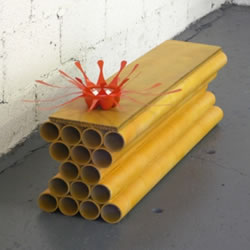
Tupanca - panca per bambini
tubi di cartone, ritagli di cartone ondulato
dimensioni: base 25 x 120cm – h 40cm
anno 2008
Riuso quindi progetto / I reuse, therefore I design
Qual è la componente “architettonica” del recupero di materiali e oggetti scartati?
Why should we call it “architecture”, the recycling of discarded materials and objects?
SB - La prima analogia tra un progetto di architettura nel senso più tradizionale e il progetto di un manufatto da realizzare tramite materiali recuperati risiede nello studio dell’armonia, delle forme e delle proporzioni. La seconda componente architettonica può essere individuata nello studio della struttura e della stabilità: uno sgabello costruito con le scatole delle uova deve essere assemblato in modo da sopportare un certo “carico”, mentre un attaccapanni fatto con tubi di cartone deve sopportare gli indumenti appesi. L’analisi degli incastri e delle superfici di rivestimento segue la stessa logica del progetto di un qualsiasi elemento di architettura: una lampada composta da tanti pezzi di bottiglia, per stare in equilibrio ed essere snodabile, ha bisogno di una struttura interna che la sostenga.
Il percorso è simile durante tutto il processo creativo che porta dal “rifiuto” al nuovo oggetto. Per avere un’idea più chiara, possiamo paragonare il riutilizzo di un oggetto alla ristrutturazione di un vecchio edificio industriale: così come, con un’adeguata serie di interventi, si può impiegare per un uso diverso da quello originario l’edificio dismesso, che altrimenti terminerebbe la sua funzione, allo stesso modo si può trasformare un semplice “rifiuto” in un oggetto utile e anche bello, che possa tornare a fare parte della quotidianità.
SB - The first similarity, between a common-intended project of architecture and the design of an object to be made up of recycled materials, resides in the study of balance, form and proportions.
The second architectural component can be identified with the study of structure and stability: a stool built from egg cartons must be assembled so that it can bear a certain “load”, whereas a coat rack made of carton tubes must sustain the hanging clothes. The analysis of joints and claddings follows the same logic as with the design of an architectural element: a lamp made up of many pieces of bottles, to stand in balance and be adjustable, needs an internal structure to support it. The path is similar throughout the creative process that leads from “waste” to the new object. To clarify, we can make a comparison between the reuse of an object and the renovation of a former industrial building: as well as, with the appropriate procedure, the neglected structure, which otherwise would lose its function, can be used for a different purpose, so we can turn a simple “waste” into a useful and nice object, in order for it to become once again a part of daily life.